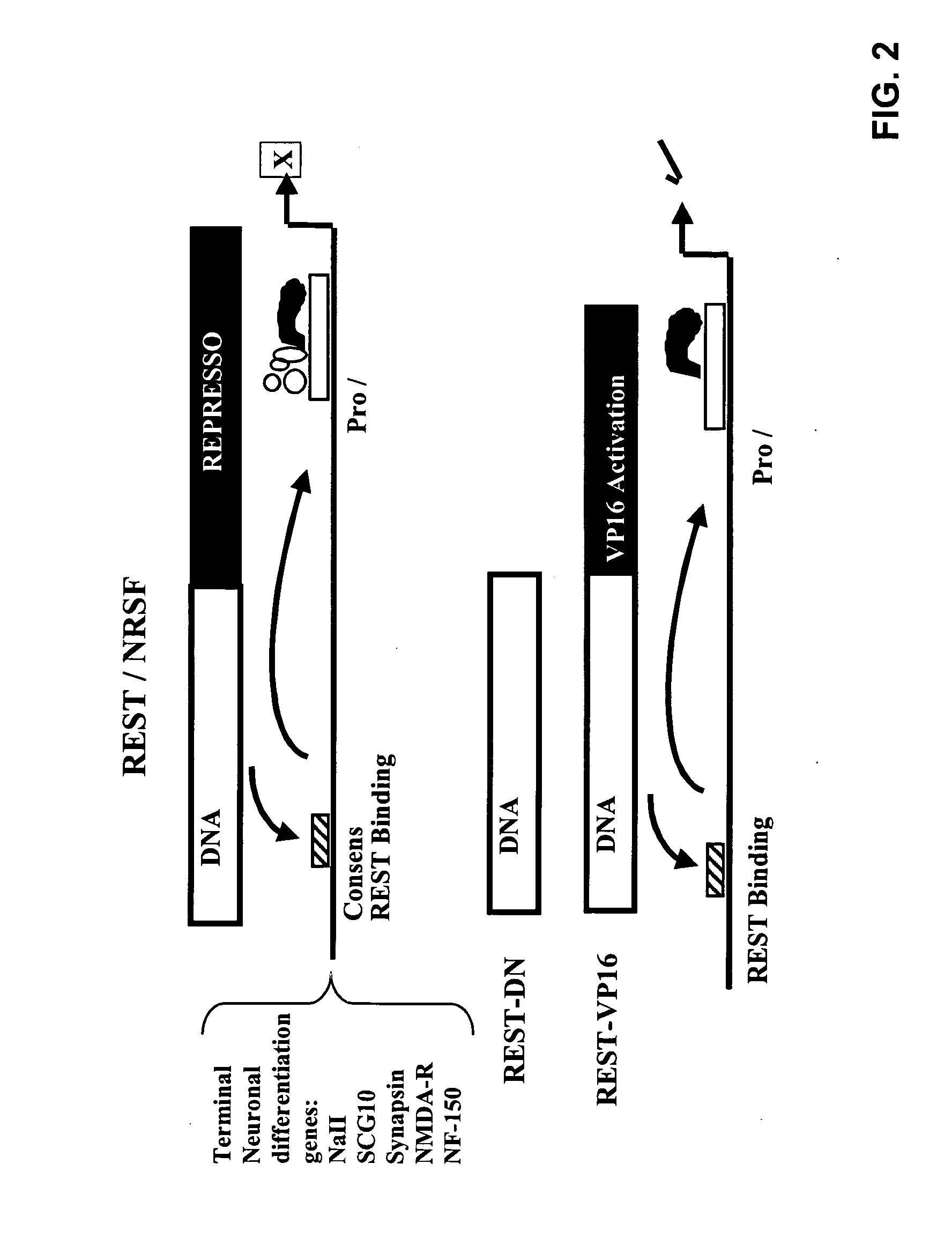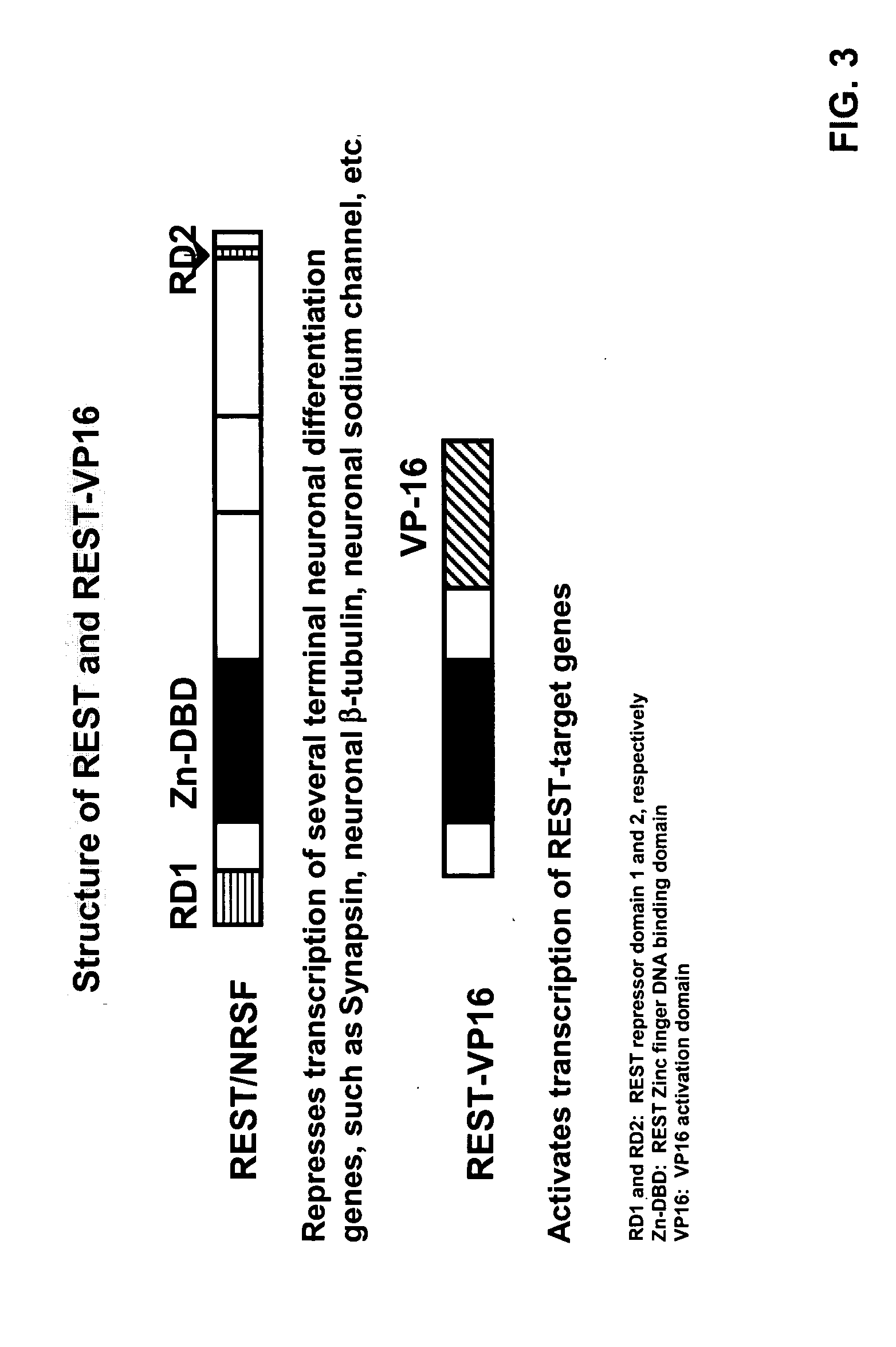Methods and compositions related to neuronal differentiation
a neuronal differentiation and composition technology, applied in the field of molecular biology, neurobiology, cell biology, etc., can solve problems such as axon guidance errors
- Summary
- Abstract
- Description
- Claims
- Application Information
AI Technical Summary
Benefits of technology
Problems solved by technology
Method used
Image
Examples
example 1
Conversion of Myoblasts to Physiolocally Active Neuronal Phenotype
[0210] A. Materials and Methods
[0211] Plasmids. The NheI / Xho I fragment of pcDNA3.1-REST-VP16 (Immaneni et al., 2000) was subcloned into the NheI / Xho I digested plasmid pBig2r (Starthdee et al., 1999). The clone obtained was confirmed by sequencing the junction region. Construction of pNaCh, pNaChARE1, pREST / NRSF, pGal4-VP16, pREST-VP16pTLuc and pRE.TLuc has been described elsewhere (Immaneni et al., 2000; Lawniger et al., 1999; Watanabe et al., 2004). The pCMV-pGAL was purchased from Stratagene Co. (La Jolla, Calif.)
[0212] Cell culture. The mouse myoblast C2C12 cells were purchased from American Type Culture Collection (Manalssas, Va.). C2C12 cells were maintained in Minimal Essential Medium (Invitrogen Co., Carlsbad, Calif.) containing 10% fetal calf serum (FCS) at 37° C. in a humidified atmosphere of 5% CO2 in air. The cells were not grown to confluence. To induce muscle differentiation, the cells were grown to ...
example 2
Activation of REST / Nrsf Target Genes 1N Neural Stem Cells is Sufficient to Cause Neuronal Differentiation
[0249] A. Materials and Methods
[0250] Plasmids. The Nhe I / Xho I fragment of pcDNA3.1-REST-VP16 (7) was subcloned into the Nhe I / Xho I digested plasmid pBig2r (Strathdee et al., 1999). The clone obtained was confirmed by sequencing the junction region. Construction of pNaCh, pNaChΔRE1, pTLuc, pRE.Tluc, pREST / NRSF, pGal4-VP16, and pREST-VP16 has been described elsewhere (Immaneni et al., 2000; Lawinger et al., 1999; Watanabe et al., 2004). The pCMV-PGAL was purchased from Stratagene Co.
[0251] Cell culture and differentiation. Mouse multipotent neural stem cells C17.2 (NSCs) were originally described by Snyder et al. (1992) and were used throughout this study. The NSCs were maintained in Dulbecco's modified Eagle's medium (DMEM) supplemented with 10% fetal calf serum (FBS) (GIBCO) and 5% horse serum (GIBCO) (growth medium) and never grown to confluence. For REST-VP16-mediated dif...
example 3
Identification of Small Molecule Modulators of REST / NRSF
[0266] The transcriptional modulating compounds described in this application can be synthesized by art recognized techniques. In certain techniques, the expression of a selective marker is put under the direct control of a promoter repressed by REST / NRSF. In the presence of REST / NRSF, the selective marker is not expressed and cells survive. Inhibition of the repression may lead to expression of a cytotoxic gene, and subsequently results in cell death. Compounds that inhibit REST / NRSF are those that induce cell death under conditions of REST / NRSF expression. In other techniques, the expression of a selective marker (e.g., URA3) is put under the direct control of a promoter repressed by REST / NRSF. Under conditions of constitutive REST / NRSF synthesis the expression of URA3 is silent. Following inhibition of REST / NRSF, and in the presence of 5-FOA the synthesis of URA3 results in cell death.
[0267] A. LANCE Screening Assay for In...
PUM
 Login to View More
Login to View More Abstract
Description
Claims
Application Information
 Login to View More
Login to View More - R&D
- Intellectual Property
- Life Sciences
- Materials
- Tech Scout
- Unparalleled Data Quality
- Higher Quality Content
- 60% Fewer Hallucinations
Browse by: Latest US Patents, China's latest patents, Technical Efficacy Thesaurus, Application Domain, Technology Topic, Popular Technical Reports.
© 2025 PatSnap. All rights reserved.Legal|Privacy policy|Modern Slavery Act Transparency Statement|Sitemap|About US| Contact US: help@patsnap.com



